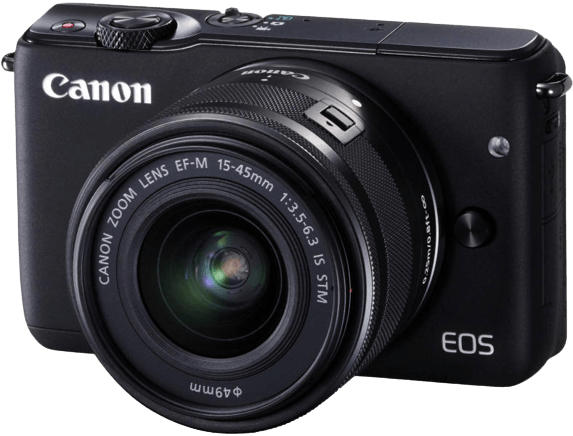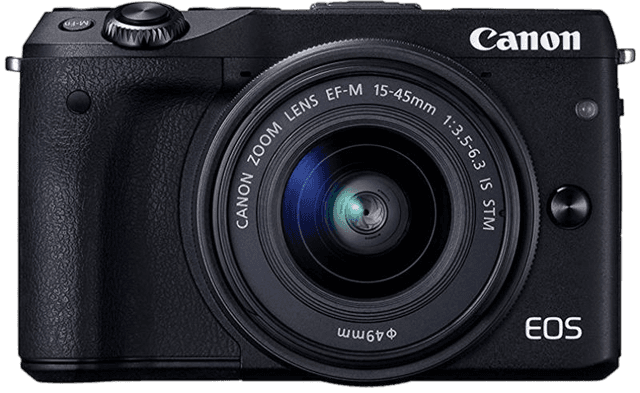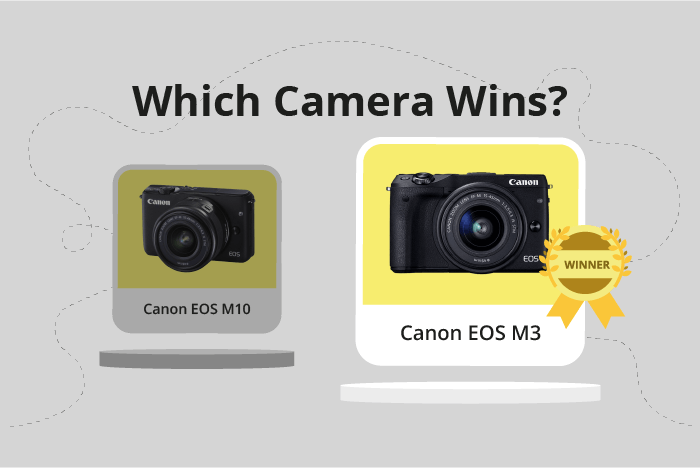Canon EOS M10 vs EOS M3 Comparison
Canon EOS M10

Canon EOS M3

The Canon EOS M3 emerges as the winner with a score of 56/100, while the Canon EOS M10 trails behind with a score of 45/100. Both cameras share common specifications, such as being mirrorless, having a similar announcement date and release year in 2015, and a close camera size.
The Canon EOS M3 stands out with its higher launch price of $870, suggesting better features and performance. Additionally, it is slightly larger and heavier at 111 x 68 x 44mm and 366g, which may indicate a more robust build.
On the other hand, the Canon EOS M10 has a lower launch price of $600, making it a more affordable option for those on a budget. It also boasts a smaller and lighter design, measuring 108 x 67 x 35mm and weighing 301g, which could be more appealing to those who prioritize portability.
Taking all these factors into account, the Canon EOS M3 proves to be a better camera with its higher score and superior features, while the Canon EOS M10 offers a budget-friendly and portable alternative.
Canon EOS M10 vs EOS M3 Overview and Optics
The Canon EOS M3 emerges as the winner in the optics comparison, scoring 60/100, while the Canon EOS M10 scores 42/100. Both cameras share some common specifications, such as the APS-C sensor size, CMOS sensor type, Digic 6 processor, Canon EF-M lens mount, and lack of image stabilization.
The EOS M3 outperforms the EOS M10 in certain aspects. It boasts a higher megapixel count of 24.2 compared to the M10’s 18 megapixels, resulting in better image resolution and detail. Additionally, the M3 has a higher DXOMARK sensor score of 72, compared to the M10’s 65. This indicates that the M3 is capable of producing superior image quality and better low-light performance.
On the other hand, the EOS M10 has a slightly faster shooting speed of 4.6 frames per second, compared to the M3’s 4.2 frames per second. This advantage might be beneficial for capturing fast-moving subjects or action shots. However, this difference is relatively small and may not be a significant deciding factor for most users.
Taking all factors into consideration, the Canon EOS M3 is the better choice for those prioritizing image quality and resolution. Its higher megapixel count and DXOMARK sensor score ensure superior performance in various shooting conditions. While the EOS M10 has a marginally faster shooting speed, it may not be sufficient to outweigh the advantages offered by the M3 in terms of optics. Thus, the Canon EOS M3 is the clear winner in this comparison.
Canon EOS M10 vs EOS M3 Video Performance
The Canon EOS M10 outperforms the Canon EOS M3 in video capabilities with a score of 57/100 compared to the M3’s 43/100. Both cameras share some common video specifications: Full HD video resolution, maximum video dimensions of 1920 x 1080, and a maximum video frame rate of 30fps. However, there are distinct differences that make the M10 a superior choice for video recording.
The Canon EOS M10 has a notable advantage in its built-in time-lapse functionality. This feature allows users to create stunning time-lapse videos without the need for additional equipment or software, which is not available in the EOS M3. The M10’s higher video score reflects its enhanced capabilities and ease of use in producing time-lapse videos.
Despite its lower video score, the Canon EOS M3 does share the same Full HD video resolution, maximum video dimensions, and maximum video frame rate as the M10. This means that the M3 can still produce high-quality videos, but it lacks the added convenience and creative options provided by the M10’s built-in time-lapse feature.
Based on the comparison of video capabilities, the Canon EOS M10 is the better choice for users who prioritize video recording and wish to experiment with time-lapse videography. The Canon EOS M3, while still capable of producing high-quality videos, lacks the time-lapse functionality, making it less versatile and user-friendly for those who want to explore this creative technique.
Canon EOS M10 vs EOS M3 Features and Benefits
The Canon EOS M10 and Canon EOS M3 both have a feature score of 57 out of 100, making it a tie in terms of features. Both cameras share several specifications, including a 3-inch screen size, a screen resolution of 1,040,000 dots, a touchscreen, a flip screen, Wi-Fi connectivity, and no GPS or Bluetooth capabilities.
The winning camera, in this case, is subjective since both cameras have the same score. However, each camera may have its own advantages depending on individual preferences and needs. For example, the Canon EOS M10 might be better for those seeking a more compact camera, while the Canon EOS M3 might offer more advanced features for experienced photographers.
On the other hand, the losing camera may still have some advantages. If the Canon EOS M10 is considered the losing camera, it might still be a good option for those on a budget or those who prioritize ease of use and simplicity. If the Canon EOS M3 is considered the losing camera, it may still be preferred by those who want more advanced features and better overall performance.
Ultimately, the choice between the Canon EOS M10 and Canon EOS M3 depends on individual preferences and needs. Both cameras have their own advantages and disadvantages, and the best choice will depend on the specific requirements of the user. Regardless of the choice, both cameras offer a range of features that make them suitable for various types of photography.
Canon EOS M10 vs EOS M3 Storage and Battery
The Canon EOS M10 and Canon EOS M3 both have a storage and battery score of 16/100, indicating no clear winner in this aspect. Both cameras share similarities in storage, as they each have one memory card slot and accept SD, SDHC, and SDXC memory cards.
In terms of battery life, the Canon EOS M10 has a slight advantage with 255 shots per charge, compared to the Canon EOS M3’s 250 shots. The M10 uses an LP-E12 battery, while the M3 uses an LP-E17 battery. However, this small difference may not have a significant impact on overall performance. Neither camera supports USB charging.
Despite the minor difference in battery life, both cameras have their merits in terms of storage and battery capabilities. The choice between the two ultimately depends on the user’s preferences and priorities in other aspects, such as features and optics, as storage and battery performance is nearly identical.
Alternatives to the Canon EOS M10 and EOS M3
Are you still undecided about which camera is right for you? Have a look at these popular comparisons that feature the Canon EOS M10 or the Canon EOS M3:

